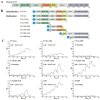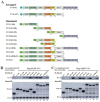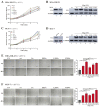YY1 Oligomerization Is Regulated by Its OPB Domain and Competes with Its Regulation of Oncoproteins
- PMID: 35406384
- PMCID: PMC8996997
- DOI: 10.3390/cancers14071611
YY1 Oligomerization Is Regulated by Its OPB Domain and Competes with Its Regulation of Oncoproteins
Abstract
Yin Yang 1 (YY1) plays an oncogenic role through regulating the expression of various cancer-related genes and activating key oncoproteins. Previous research reported that YY1 protein formed dimers or oligomers without definite biological implications. In this study, we first demonstrated the oncoprotein binding (OPB) and zinc finger (ZF) domains of YY1 as the regions involved in its intermolecular interactions. ZFs are well-known for protein dimerization, so we focused on the OPB domain. After mutating three hydrophobic residues in the OPB to alanines, we discovered that YY1(F219A) and YY1(3A), three residues simultaneously replaced by alanines, were defective of intermolecular interaction. Meanwhile, the OPB peptide could robustly facilitate YY1 protein oligomerization. When expressed in breast cancer cells with concurrent endogenous YY1 knockdown, YY1(F219A) and (3A) mutants showed better capacity than wt in promoting cell proliferation and migration, while their interactions with EZH2, AKT and MDM2 showed differential alterations, especially with improved EZH2 binding affinity. Our study revealed a crucial role of the OPB domain in facilitating YY1 oligomerization and suggested a mutually exclusive regulation between YY1-mediated enhancer formation and its activities in promoting oncoproteins.
Keywords: OPB; YY1; oligomerization; oncoprotein; transcription factor; zinc finger.
Conflict of interest statement
The authors declare no competing interest.
Figures










Similar articles
-
Zinc Ions Modulate YY1 Activity: Relevance in Carcinogenesis.Cancers (Basel). 2023 Aug 30;15(17):4338. doi: 10.3390/cancers15174338. Cancers (Basel). 2023. PMID: 37686614 Free PMC article. Review.
-
Characterization of YY1 OPB Peptide for its Anticancer Activity.Curr Cancer Drug Targets. 2019;19(6):504-511. doi: 10.2174/1568009618666181031153151. Curr Cancer Drug Targets. 2019. PMID: 30381079
-
Yin Yang 1 promotes mTORC2-mediated AKT phosphorylation.J Mol Cell Biol. 2016 Jun;8(3):232-43. doi: 10.1093/jmcb/mjw002. Epub 2016 Jan 13. J Mol Cell Biol. 2016. PMID: 26762111 Free PMC article.
-
Disruption of YY1-EZH2 Interaction Using Synthetic Peptides Inhibits Breast Cancer Development.Cancers (Basel). 2021 May 16;13(10):2402. doi: 10.3390/cancers13102402. Cancers (Basel). 2021. PMID: 34065631 Free PMC article.
-
The biological implications of Yin Yang 1 in the hallmarks of cancer.Theranostics. 2020 Mar 4;10(9):4183-4200. doi: 10.7150/thno.43481. eCollection 2020. Theranostics. 2020. PMID: 32226547 Free PMC article. Review.
Cited by
-
Targeting Transcription Factor YY1 for Cancer Treatment: Current Strategies and Future Directions.Cancers (Basel). 2023 Jul 5;15(13):3506. doi: 10.3390/cancers15133506. Cancers (Basel). 2023. PMID: 37444616 Free PMC article. Review.
-
Yin Yang 1: Function, Mechanisms, and Glia.Neurochem Res. 2025 Feb 4;50(2):96. doi: 10.1007/s11064-025-04345-7. Neurochem Res. 2025. PMID: 39904836 Free PMC article. Review.
-
Zinc Ions Modulate YY1 Activity: Relevance in Carcinogenesis.Cancers (Basel). 2023 Aug 30;15(17):4338. doi: 10.3390/cancers15174338. Cancers (Basel). 2023. PMID: 37686614 Free PMC article. Review.
-
Yin Yang 1: Role in Leishmaniasis.Cells. 2025 Jul 25;14(15):1149. doi: 10.3390/cells14151149. Cells. 2025. PMID: 40801584 Free PMC article. Review.
-
Mechanisms of enhancer-promoter communication and chromosomal architecture in mammals and Drosophila.Front Genet. 2022 Dec 1;13:1081088. doi: 10.3389/fgene.2022.1081088. eCollection 2022. Front Genet. 2022. PMID: 36531247 Free PMC article. Review.
References
Grants and funding
LinkOut - more resources
Full Text Sources
Research Materials

